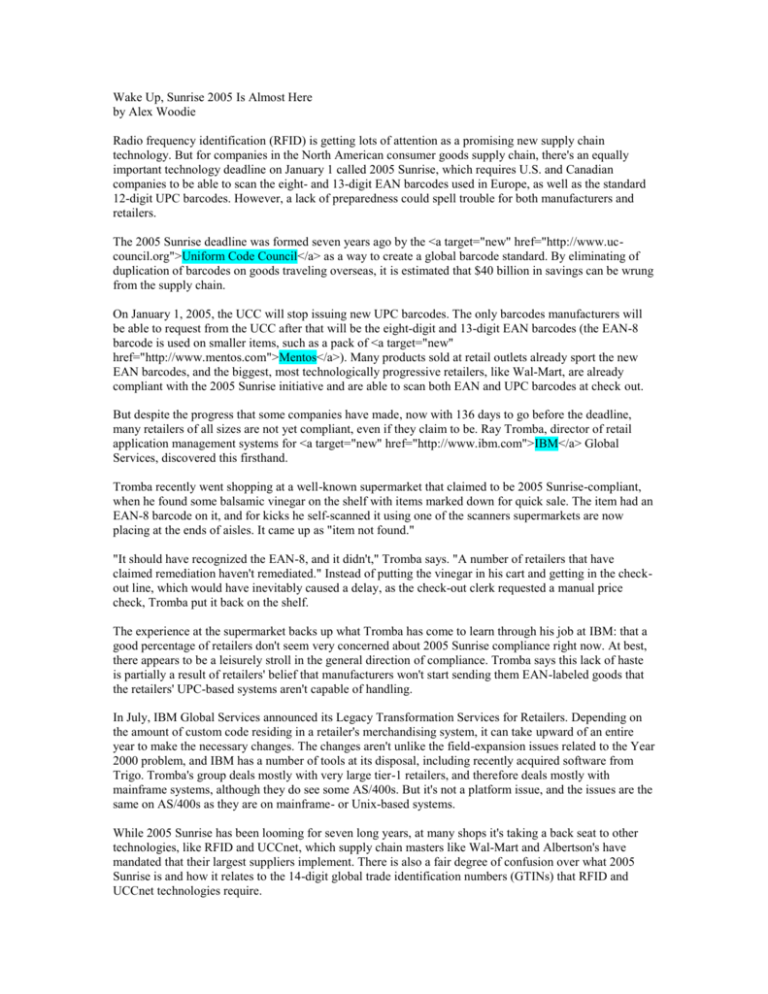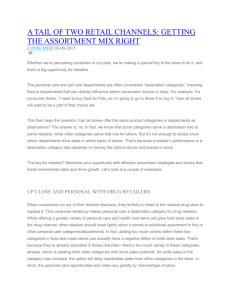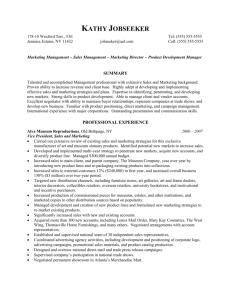Wake Up, Sunrise 2005 is Almost Here
advertisement

Wake Up, Sunrise 2005 Is Almost Here by Alex Woodie Radio frequency identification (RFID) is getting lots of attention as a promising new supply chain technology. But for companies in the North American consumer goods supply chain, there's an equally important technology deadline on January 1 called 2005 Sunrise, which requires U.S. and Canadian companies to be able to scan the eight- and 13-digit EAN barcodes used in Europe, as well as the standard 12-digit UPC barcodes. However, a lack of preparedness could spell trouble for both manufacturers and retailers. The 2005 Sunrise deadline was formed seven years ago by the <a target="new" href="http://www.uccouncil.org">Uniform Code Council</a> as a way to create a global barcode standard. By eliminating of duplication of barcodes on goods traveling overseas, it is estimated that $40 billion in savings can be wrung from the supply chain. On January 1, 2005, the UCC will stop issuing new UPC barcodes. The only barcodes manufacturers will be able to request from the UCC after that will be the eight-digit and 13-digit EAN barcodes (the EAN-8 barcode is used on smaller items, such as a pack of <a target="new" href="http://www.mentos.com">Mentos</a>). Many products sold at retail outlets already sport the new EAN barcodes, and the biggest, most technologically progressive retailers, like Wal-Mart, are already compliant with the 2005 Sunrise initiative and are able to scan both EAN and UPC barcodes at check out. But despite the progress that some companies have made, now with 136 days to go before the deadline, many retailers of all sizes are not yet compliant, even if they claim to be. Ray Tromba, director of retail application management systems for <a target="new" href="http://www.ibm.com">IBM</a> Global Services, discovered this firsthand. Tromba recently went shopping at a well-known supermarket that claimed to be 2005 Sunrise-compliant, when he found some balsamic vinegar on the shelf with items marked down for quick sale. The item had an EAN-8 barcode on it, and for kicks he self-scanned it using one of the scanners supermarkets are now placing at the ends of aisles. It came up as "item not found." "It should have recognized the EAN-8, and it didn't," Tromba says. "A number of retailers that have claimed remediation haven't remediated." Instead of putting the vinegar in his cart and getting in the checkout line, which would have inevitably caused a delay, as the check-out clerk requested a manual price check, Tromba put it back on the shelf. The experience at the supermarket backs up what Tromba has come to learn through his job at IBM: that a good percentage of retailers don't seem very concerned about 2005 Sunrise compliance right now. At best, there appears to be a leisurely stroll in the general direction of compliance. Tromba says this lack of haste is partially a result of retailers' belief that manufacturers won't start sending them EAN-labeled goods that the retailers' UPC-based systems aren't capable of handling. In July, IBM Global Services announced its Legacy Transformation Services for Retailers. Depending on the amount of custom code residing in a retailer's merchandising system, it can take upward of an entire year to make the necessary changes. The changes aren't unlike the field-expansion issues related to the Year 2000 problem, and IBM has a number of tools at its disposal, including recently acquired software from Trigo. Tromba's group deals mostly with very large tier-1 retailers, and therefore deals mostly with mainframe systems, although they do see some AS/400s. But it's not a platform issue, and the issues are the same on AS/400s as they are on mainframe- or Unix-based systems. While 2005 Sunrise has been looming for seven long years, at many shops it's taking a back seat to other technologies, like RFID and UCCnet, which supply chain masters like Wal-Mart and Albertson's have mandated that their largest suppliers implement. There is also a fair degree of confusion over what 2005 Sunrise is and how it relates to the 14-digit global trade identification numbers (GTINs) that RFID and UCCnet technologies require. Instead of moving from 12-to-13-digit-capable systems now, and then from 13-to-14-digit-capable systems sometime in the future, Tromba and IBM recommend that suppliers consider doing all the remediation work at once. So when will retailers start getting with the 2005 Sunrise program and make the changes in their systems that will allow them to sell products with the European barcodes, without causing massive traffic jams in the check-out lines and angering consumers? Tromba says that this won't happen until retailers have no choice but to start accepting products with the EAN-13 or EAN-8 barcodes--perhaps, he says, when some hot new low-carb product hits the market (remember, the UCC won't provide any new UPC barcodes after January 1). "My estimate is probably mid-year to the second half" of 2005, he says. "I think they should be thinking about it now." Scott Langdoc, a supply chain analyst with <a target="new" href="http://www.amrresearch.com">AMR Research</a>, wonders why retailers and suppliers aren't working more closely together. "Despite suppliers' desire to tell the retailer that it's the retailer's problem, suppliers will be forced to bend to retailer power, setting collaboration efforts two steps back," he wrote in a June "Alert Highlight."




![[DATE] Mary Ziegler Director Division of Regulations, Legislation](http://s3.studylib.net/store/data/007212021_1-b96b03cd98cadfc74a22865c0247494d-300x300.png)


